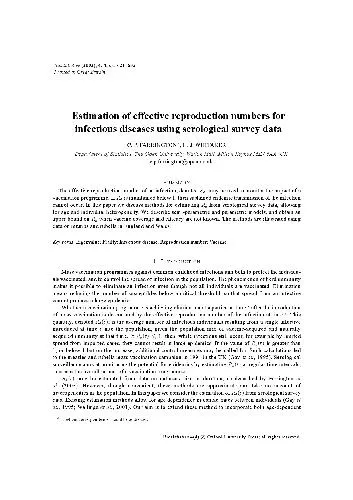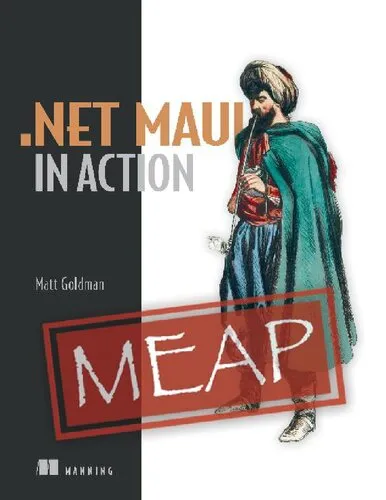Estimation of effective reproduction numbers for infectious diseases using serological survey data
4.3
بر اساس نظر کاربران

شما میتونید سوالاتتون در باره کتاب رو از هوش مصنوعیش بعد از ورود بپرسید
هر دانلود یا پرسش از هوش مصنوعی 2 امتیاز لازم دارد، برای بدست آوردن امتیاز رایگان، به صفحه ی راهنمای امتیازات سر بزنید و یک سری کار ارزشمند انجام بدینکتاب های مرتبط:
خلاصه کتاب
کتاب "Estimation of effective reproduction numbers for infectious diseases using serological survey data" به بررسی یکی از بحثبرانگیزترین و مهمترین مفاهیم اپیدمیولوژی، یعنی "effective reproduction number" یا به اختصار Re، میپردازد. این کتاب نوشتهی "Farrington C.P." و "Whitaker H.G."، به ارائه روشهای نوینی برای برآورد Re از طریق دادههای سرولوژیکی میپردازد. بیماریهای عفونی با دینامیک پیچیده، نیازمند تحلیلهای دقیق و پیشرفتهاند تا بتوان راهبردهای کنترلی مؤثری اتخاذ نمود. مولفان در این کتاب به روشهای ابتکاری و کاربردی میپردازند که برای طیف گستردهای از بیماریها قابل استفاده است.
نکات کلیدی
این کتاب بر اهمیت دادههای سرولوژیکی در تحلیل انتشار بیماریهای عفونی تمرکز دارد و روشهای آماری و ریاضی پیشرفتهای را برای تحلیل این دادهها معرفی میکند. به کمک این تکنیکها، مسئولین بهداشتی میتوانند تصمیمات آگاهانهتری بگیرند و موثرتر عمل کنند. این روش ها امکان برآورد دقیقتر از نرخهای انتشار را فراهم میآورند و در نهایت به کنترل بیماری کمک میکنند. فهم صحیح Re برای پیشبینی و برنامهریزیهای کنترلی اهمیت ویژهای دارد و این کتاب راهکارهایی ارائه میدهد که درک و استفاده از این مفهوم را تسهیل مینماید.
جملات معروف از کتاب
"معنای واقعی شاخص Re در گرو شناخت بستر اپیدمیولوژیک و اجتماعی است که در آن محاسبه و تفسیر میگردد." این جمله الهامبخش تأکید بر اهمیت زمینهسنجیهای صحیح در تحلیل دادهها دارد و این که چگونه دادههای سرولوژیکی میتوانند این زمینه را بهتر روشن کنند.
چرا این کتاب مهم است
ابزارها و روشهای ارائه شده در این کتاب برای همه کسانی که در زمینه بهداشت عمومی و اپیدمیولوژی کار میکنند حیاتی است. افزایش دقت در برآورد Re به معنای اتخاذ تصمیمات بهتر در زمینه کنترل و مدیریت بیماریهای عفونی است. در دنیای امروز، که بیماریهای همهگیر میتوانند به سرعت مرزهای جغرافیایی را درنوردند، چنین پژوهشها و کتابهایی نقشی کلیدی در افزایش آگاهی و آمادگی جهانی ایفا میکنند.
Welcome to the detailed exploration of 'Estimation of Effective Reproduction Numbers for Infectious Diseases Using Serological Survey Data,' an essential resource that navigates the complexities of epidemiological modeling and the estimation of effective reproduction numbers (R) through the lens of serological data. In an era where infectious diseases and pandemics have captured global attention, understanding how these diseases spread and recur becomes paramount. With this book, authors Farrington C.P. and Whitaker H.G. delve into advanced methods and provide a robust framework for epidemiologists, public health experts, and researchers seeking to grasp the dynamics of infectious disease transmission.
Detailed Summary of the Book
The core of this book revolves around the critical epidemiological parameter known as the effective reproduction number (R), which plays a pivotal role in comprehending the rate at which an infectious disease spreads within a population. Typically, R is the average number of secondary infections produced by a single infectious individual in a completely susceptible population. Estimating this number accurately, especially in the context of varying immunity levels due to past infections or vaccinations, is crucial for designing effective control measures and response strategies.
'Estimation of Effective Reproduction Numbers for Infectious Diseases Using Serological Survey Data' addresses the gap in the traditional approaches by incorporating serological data—data obtained from blood tests that measure the presence of antibodies indicative of past exposure to infectious agents. This book provides holistic insights into how serological surveys can inform and refine our understanding of R, accounting for both the susceptible fraction of the population and the rate of contact between individuals.
Structured over several chapters, the book covers essential methodologies, starting from the foundational basics of infectious disease modeling, moving into complex statistical techniques required for proper estimation. Key topics include the interpretation of serology tests, design and implementation of serological surveys, statistical methods for data integration, and case studies from real-world scenarios where serological data has been pivotal in controlling disease spread.
Key Takeaways
- Understanding the importance of using serological data to enhance the accuracy of reproduction number estimates.
- Insight into real-world applications through case studies, demonstrating the practical implications of theory.
- A comprehensive overview of statistical methods involved in the estimation of epidemiological parameters.
- Guidelines for implementing and interpreting serological surveys effectively within public health frameworks.
Famous Quotes from the Book
"In the fluctuating landscape of infectious disease epidemiology, serological data serve as beacons, guiding accurate estimation of transmission dynamics."
"Effective reproduction numbers are more than just figures; they are reflections of underlying societal behaviors and immune protections."
Why This Book Matters
In the field of epidemiology and public health, accurate data and timely intervention are the keys to mitigating the impact of infectious diseases. This book is significant because it bridges a crucial gap between theoretical epidemiology and applied public health, providing a methodological backbone that is indispensable for academics, researchers, and policymakers. Especially in light of recent global health crises, this resource offers the tools and insights needed to enhance preparedness and response strategies, emphasizing the evolution of science to direct public health actions effectively.
The authors bring their extensive expertise, presenting complex statistical and epidemiological concepts in an accessible manner—inviting a broader audience to understand and utilize serological data effectively. As health landscapes continue to evolve, integrating novel methodologies with traditional models, such as proposed in this book, will prove to be pivotal in the fight against future pandemics.
دانلود رایگان مستقیم
شما میتونید سوالاتتون در باره کتاب رو از هوش مصنوعیش بعد از ورود بپرسید
دسترسی به کتابها از طریق پلتفرمهای قانونی و کتابخانههای عمومی نه تنها از حقوق نویسندگان و ناشران حمایت میکند، بلکه به پایداری فرهنگ کتابخوانی نیز کمک میرساند. پیش از دانلود، لحظهای به بررسی این گزینهها فکر کنید.
این کتاب رو در پلتفرم های دیگه ببینید
WorldCat به شما کمک میکنه تا کتاب ها رو در کتابخانه های سراسر دنیا پیدا کنید
امتیازها، نظرات تخصصی و صحبت ها درباره کتاب را در Goodreads ببینید
کتابهای کمیاب یا دست دوم را در AbeBooks پیدا کنید و بخرید
1343
بازدید4.3
امتیاز0
نظر98%
رضایتنظرات:
4.3
بر اساس 0 نظر کاربران
Questions & Answers
Ask questions about this book or help others by answering
No questions yet. Be the first to ask!








